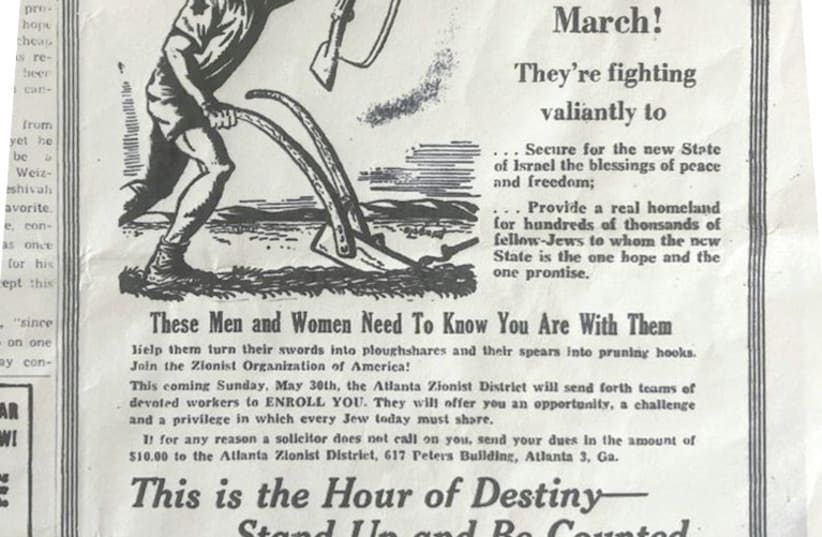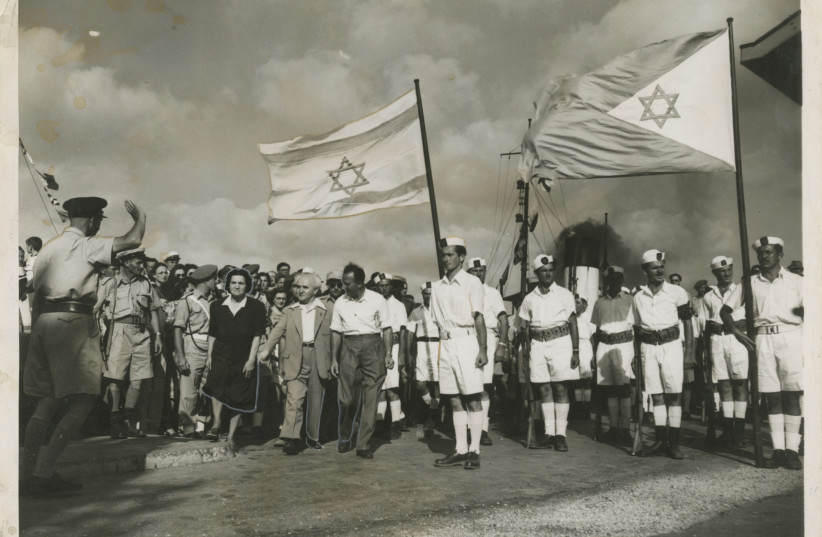The 75th anniversary of Israel has arrived. Who would have ever believed it?
“A people divorced from its land for almost 2,000 years and exposed to the corrosive acids of human brutality,” Rabbi Sidney Greenberg writes. “A people whose dreams of restoration had been mocked by circumstances never to be believed.
“That such a people could achieve the fulfillment of the most cherished and long deferred hope at the precise moment when the hand of despair lay most heavily upon it, the Holocaust... that proves the invincibility of the human spirit when wedded to an imperishable ideal.”
I was too young to appreciate the moving drasha (sermon) given on Shabbat, May 15, the day after Israel was born, by my grandfather, Rav Tuvia Geffen. So in recent years as I turned older, I sought to find a fellow Atlantan Jew who truly remembered that incredible event.
Seven years ago, I asked the honorable Elliott Levitas to share his experience. Levitas, who passed away this year at 91, was the first Jewish Congressman from the State of Georgia. He was a noted individual, Rhodes scholar, and the most honored alumnus of Emory University in the past half century.
He was present at the Ahavat Achim Synagogue in Atlanta on that Saturday night, May 15, 1948, the day after Israel became a state, and he shared with me his poignant memories.
“Palpable joy could be felt. At that time, I knew I would never forget the moment,” he said. “The most impressive speaker was a tall Christian minister, who had been on the Exodus. How he thrilled the audience!”
Levitas never forgot what happened next. “His concluding words reverberated throughout the large hall and brought the crowd to its feet, cheering YIS*RA*EL!!!
“It was a strangely transformative experience [for me]. All of a sudden, I felt different. There was now at last a Jewish state reestablished after all these very dark centuries, and I was a Jew living to see it happen,” said Levitas
Atlanta Jews and Christians came to Israel’s side quickly.
On May 28, 1948, 14 days after Israel was born, the Southern Israelite weekly of Atlanta carried an ad with a powerful image of an Israeli soldier, gun raised in one hand and a plow in the other. Under the auspices of the ZOA chapter of Atlanta, money and weaponry were sought openly. Now the arms embargo of the United States no longer existed, and there was no fear of American federal officials.
“Close Your Ranks” and “Jewish Soldiers on the March,” the ad read.
“Secure for the new State of Israel the blessings of freedom: Provide a real homeland for hundreds of thousands of fellow Jews to whom the new State of Israel is the new hope and one promise. This is the Hour of Destiny – Stand Up and BE COUNTED.”
American Jews who left to fight for Israel
The American Jews who secretly left the United States to fight for Israel in 1948 and 1949 were moved to place their lives on the line to assure that Israel would survive. I was fortunate to know two personally – one who became my teacher and one whom I worked with in the 1970s before making aliyah.
Norman Schutzman from Wilmington, Delaware, was a lieutenant in World War II and served in the European theater. After the war, he returned to his home and spent a year or two in college. In January 1948, Schutzman disappeared from his parents’ home and got through American customs, flew to Europe and was smuggled into then Palestine.
Because he was an officer, he was put in charge of a unit near Safed. In a diary by a South African volunteer, who was in Schutzman’s unit, you receive a firsthand impression of what was transpiring. “Norman led us as we went on a secret raid to an Arab village. There were more guns there than we expected. A heavy battle ensued. Several of our boys were wounded. Schutzman went from man to man boosting confidence. After intense fighting, the Arabs retreated and we took the village.”
Schutzman, with whom I spent many hours in Wilmington, was a tall lanky man with a slight Delaware accent. He was in the service for almost three years in World War II. I am not sure any of his family or friends realized just how much he loved Israel.
Another passage in the diary points to Norman’s leadership. “In the vicinity of Safed, we were ambushed. Some of our unit were killed. We had to pull back. Schutzman himself stayed near the ambushers and held them off so we could retreat safely. We kept looking for him. Finally, he returned slightly wounded but already thinking about the next day and our next encounter.”
When Schutzman returned to Wilmington in December 1948, he completed a college degree, married, and began a small business. He was elected president of his synagogue, and every Jewish organization in the city. He helped in the sale of several million Israel Bonds.
My Hebrew school teacher, Irving Citron, was seriously wounded in the Battle of the Bulge. He returned to Atlanta a year after the war and completed his bachelor of science (engineering) at Georgia Technical University.
He got a job at an African-American college, where he taught for a year. Then he returned to Atlanta and taught our Hebrew school class every Sunday. Then Citron, like Schutzman, sneaked out of the US via Canada. By the time of his arrival in Israel in January 1949, Israel was a state, so he immediately joined the Israel Defense Forces.
Many years later when I saw him, he kidded about leaving our class. “I had to go Israel and fight for our nation,” he said.
American Jews of my generation were under 10 when Israel was born. I chose to select a friend, Rabbi Dov Elkins, who lives in Jerusalem with his wife, Miryam, to provide his experiences from that period.
We turn the calendar back to the 1940s, just before the creation of Israel as a nation. Elkins exemplified the youth, myself included, who had real tasks to assist Israel. There were cards from the Jewish National Fund with space for 10 dimes. Once a card was filled, the name of the person who completed the card was passed on to the Jewish National Fund office. A tree certificate was issued, and a tree was planted in a budding forest in Israel.
Elkins also had a pushke JNF box. Often, he would go to the homes of Jews in his neighborhood in Philadelphia and solicit pennies, nickels, quarters, half dollars for his blue-and-white box.
I learned from him that in 1949, prior to his bar mitzvah, his father took him to a soccer game in Philadelphia. Before World War II, it became routine for soccer teams like Maccabi Tel Aviv to come to the US to play exhibition games. After the war was over, even under British rule, the teams returned. Since American soccer was just an adventure in the park or a Sunday activity, the Israel teams won handily. No individual Jewish American soccer player has yet to become a professional in Israel.
However, the Olympian Tal Brody led the Maccabi Tel Aviv team to the European championship in 1977. Just as Israeli flags are so important now, the Elkins – father and son – bought one, which was mounted on a stick, and placed it on their front lawn. A love for Eretz Yisrael buried deep in the mind of young American Jews.
In 1920 Deborah Kallen, sister of famed Zionist thinker Professor Horace Kallen, moved to Palestine. Prof. Hillel Blondheim was brought to Eretz Yisrael by his mother in 1928 for eight months. She enrolled him in Miss Kallen’s School. He wrote about his experiences in his autobiography. He told me once when we met, “Every week we had a trip somewhere in Eretz Yisrael near Jerusalem. As I walk around Jerusalem today, I see streets bearing the names of our guides back then.” Blondheim made aliyah in 1951 and lived in Jerusalem until his 100th birthday. He became a noted scientist and won many prizes.
Kallen’s goal was to establish the Parents Educational Association School. Immediately, housed in old Arab building in Jerusalem, she made her educational theories come to life through the creation of classes in painting, carpentry, and athletics. Daily gardening, crafts were part of the regular curriculum, and nature walks. Yigael Yadin, the world-renowned archaeologist, was one of her students.
There were Christians who worked for the birth of a homeland for the Jewish people. One was Ralph McGill, the editor of the Atlanta Constitution. A native of Tennessee, he moved to the Atlanta paper to be the sports editor.
However, it soon became clear that his abilities went far beyond athletics. He was awarded a six-month fellowship to study agriculture in Austria.
He and his wife were in Vienna when Hitler marched in and the country surrendered. That day, they were visiting a Jewish family to whom they brought information about escape from the country so they would survive. Peeking through the closed shades, they watched the Austrians welcome Hitler with joy as he marched in triumphantly.
On his return to Atlanta, McGill talked about the boldness and patriotism of the American Jews. He answered the antisemitic complaints that the American Jews were not doing their share in the fighting to destroy Hitler.
After the war, Herbert Bayer Swope, a great American Jewish journalist, winner of the first Pulitzer Prize awarded, asked McGill to travel to Europe, Egypt, and Palestine to get the “real story.”
The McGill articles published after his trip called for “the immediate establishment of a Jewish state.” His book Israel Revisited contained all the articles he had sent from Austria, Nuremberg, Cairo and numerous ones from Palestine.
From March 1946 when he returned after completing the Swope trip, he spoke in Atlanta and other cities. Over the radio in Boston, he participated in a forum in which he detailed how the Jews had suffered during the Holocaust, how the refugees were languishing in camps sometimes even worse than concentration camps. There was a country to which they could go but the British would not let them enter. “A Jewish state immediately” resounded over the radio in 10 states.
One of the individuals who traveled in the US securing arms was Reuven Dafni, later head of Yad Vashem. In Atlanta, McGill introduced him to Robert Travis, leader of the secret campaign for arms, as well as Christians who wanted to share the burden and assure a homeland for the Jews.
After the War of Independence, Gershon Agron, the founder of The Jerusalem Post in 1932, served as press officer in Ben-Gurion’s government.
He invited McGill and his wife to visit Israel. At numerous ceremonies he was saluted for his efforts to bring the Jewish nation into being.
Rabbi Dov Elkins has penned a new work, among his many previous ones, showing his love for Israel in a fascinating manner. During his lifetime, he has focused in his writing and his lectures about two major symbols representative of the Jewish people and the Jewish state. He titles the study “The Battle between the Menorah and the Magen David.”
Providing written proofs and images of the two throughout Jewish history, he whets our appetite for a conclusion that will satisfy. We are aware that “each symbol has found an honored place – one on the flag of the State of Israel and one on the official emblem of Israel.”
There is no winner, he concludes. “Let’s wait until the coming of Elijah and the Messiah to resolve this unresolved question, too,” he writes. ■

